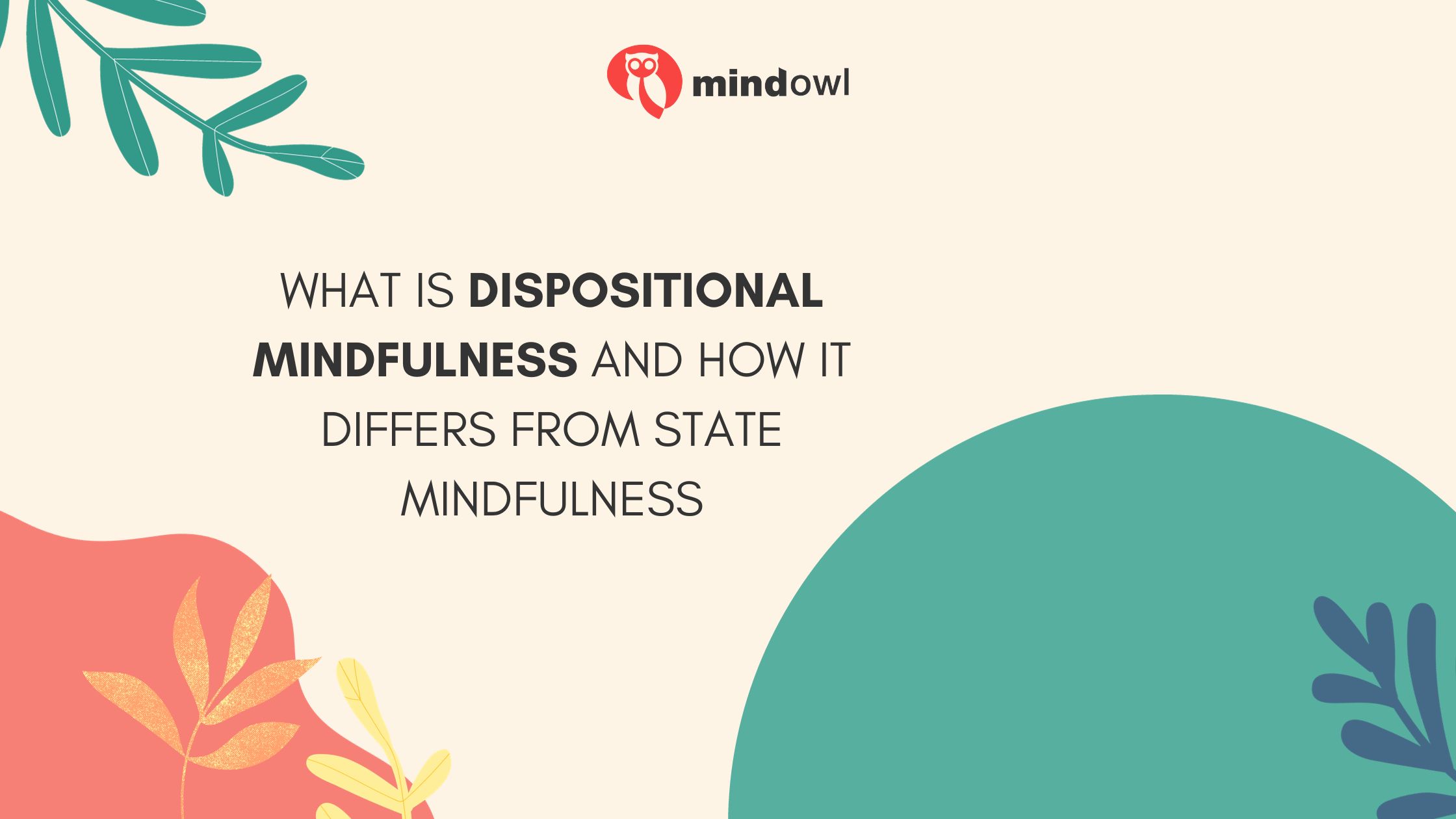
In recent years, mindfulness has gained significant attention as a practice that can help individuals better navigate the challenges of everyday life. However, within the realm of mindfulness, there exists a distinction between dispositional mindfulness and state mindfulness. Dispositional mindfulness refers to a long-term, stable trait or characteristic of an individual, whereas state mindfulness refers to a temporary, in-the-moment state of awareness.
Dispositional mindfulness is often seen as a deeper, more ingrained quality that shapes the way a person perceives and interacts with the world. It is a fundamental aspect of one’s personality, influencing how they approach and respond to various situations. In contrast, state mindfulness refers to the temporary focus and awareness that can be cultivated through mindful practices such as meditation.
Understanding the difference between dispositional and state mindfulness is crucial in developing a comprehensive understanding of the concept and its potential impact on individuals’ well-being. In this article, we will explore the nature of dispositional mindfulness, its significance, and how it differs from state mindfulness.
Key Takeaways
- Dispositional mindfulness is a person’s natural way of being aware and present without judging. It’s different from state mindfulness, which is temporary and often comes from activities like meditation.
- People with high dispositional mindfulness usually handle feelings better, feel happier, and get less sad or worried than those who don’t have this trait naturally.
- You can work on becoming more dispositionally mindful by doing everyday things mindfully, like eating slowly or focusing on your steps when you walk. This can help make being mindful a normal part of your life.
- Mindful actions might make you eat healthier and enjoy exercise more because they help focus your attention on what you’re doing right now. This can also mean a happier life overall.
- Still, research isn’t perfect. It needs to look at different kinds of people over longer times to really know how dispositional mindfulness works for everyone. Future studies should dig deeper into how it helps our minds and bodies stay healthy.
Understanding Dispositional Mindfulness

Dispositional mindfulness refers to an individual’s innate tendency to be mindful, as opposed to the temporary state of mindfulness that can fluctuate throughout the day. It involves a consistent and stable awareness of one’s thoughts, emotions, and surroundings.
Definition of dispositional mindfulness
Dispositional mindfulness means having a sharp focus on what you are thinking and feeling right now, without judging. It’s like a natural skill that helps you be fully aware of the present moment.
This kind of mindfulness is different from what we do in meditation because it is part of who you are all the time, not just when you try to practice it.
The Mindful Attention Awareness Scale (MAAS) helps measure how mindful someone is in their daily life. Being high in dispositional mindfulness means that a person often lives in the moment and pays attention to their experiences without getting swept away by their thoughts or feelings.
Difference between dispositional mindfulness and state mindfulness
Understanding dispositional mindfulness helps us see how it is different from state mindfulness. Dispositional mindfulness is a part of who you are. It means you often pay attention to the present and do not judge what’s happening around you.
On the other hand, state mindfulness is about being aware right now but doesn’t always happen. Fancy words aside, think of dispositional mindfulness as your everyday mindset that helps you stay calm and focused, while state mindfulness is like flipping a switch on when you need to be extra attentive to what’s going on at this very moment.
People with high levels of dispositional mindfulness can handle their feelings better and have more joy in life. They tend to feel less sad or worried compared to others who might not be naturally mindful all the time.
With state mindfulness, these good things come too, but only for the time when someone is actively practicing being mindful – such as during meditation or deep breathing exercises.
So, although both types of mindfulness make us aware of our thoughts and feelings, they work differently depending on whether it’s part of your personality or something you do sometimes.
Benefits of Dispositional Mindfulness

Developing dispositional mindfulness can lead to an improved connection to the present moment and better management of stress and conflict. These benefits can positively impact mental well-being and overall quality of life.
Improved connection to the present moment
Paying attention to the now helps you feel life as it happens. You notice small things like a breeze or a bird’s song. Dispositional mindfulness makes this easier. It means your mind stays in the moment, not lost in past memories or future worries.
Being mindful lets you enjoy things more. You can really taste your food, hear music better, and see the world brightly. This is because dispositional mindfulness stops your mind from wandering too much.
So you live life fuller and get more joy from everyday stuff.
Better management of stress and conflict
Dispositional mindfulness can be like a shield against stress and arguments. It helps folks stay cool and see things clearly. When someone has this kind of mindfulness, they don’t get upset so easily.
They can talk through problems without losing their temper or getting too worried.
People with high dispositional mindfulness know how to deal with tough times better. Instead of letting bad feelings take over, they handle them in a helpful way. This can lead to less fighting and more peace in their lives.
They use their calm mind to sort out what’s happening and find good ways to fix things without making a fuss.
How to Develop Dispositional Mindfulness
Developing dispositional mindfulness requires transitioning from state mindfulness to trait mindfulness, which involves incorporating mindfulness practices into your daily routine and consistently cultivating a mindset of present-moment awareness.
This can be achieved through various mindfulness practices such as mindful eating, walking, or creativity exercises that help in fostering a deeper connection with the present moment.
Going from state mindfulness to trait mindfulness
You can turn the mindfulness you get from meditating into a part of who you are. It’s like learning to ride a bike; at first, it feels hard, but over time it becomes natural. Each time you focus and bring your mind back during meditation, you’re building up your ability to be mindful in everyday life.
Adding little moments of mindfulness throughout your day helps too. You might take a deep breath before answering the phone or notice how your feet feel on the ground as you walk. Keep doing these small things often and they start to stick with you, shaping a more mindful way of living that doesn’t need any special effort.
Incorporating mindfulness practices into daily routine
Making mindfulness a regular part of your day helps you focus and stay calm. It’s like building a mental muscle to stay present and enjoy life more.
- Start your day with a few deep breaths. Before you get out of bed, take a moment to notice your breathing. Feel the air fill your lungs and then slowly breathe out.
- Eat mindfully at each meal. Pay attention to the taste, texture, and smell of your food. Take small bites and chew well.
- Pause between tasks. After finishing one thing, stop for a minute before starting the next. Notice how you feel.
- Set reminders to check in with yourself. A sticky note or phone alert can nudge you to pause and notice what’s happening around you and inside you.
- Use mindful cues in your environment. When you see something common, like a red light or hear the phone ring, use it as a cue to take a mindful breath.
Mindfulness Practices for Dispositional Mindfulness
To develop dispositional mindfulness, individuals can engage in various mindfulness practices such as mindful eating, mindful walking, and mindful creativity. These practices help to cultivate an awareness of the present moment and promote a sense of calm and focus.
Mindful eating
Mindful eating is about paying close attention to the experience of eating. You slow down and notice how your food looks, smells, and tastes. This practice helps you enjoy your meal more and listen to your body’s hunger signals.
When you eat mindfully, you may find that you eat less because you are aware of feeling full sooner.
Eating this way can lead to healthier choices and even help with problems like eating too much when sad or stressed. It turns out that people who practice mindful eating often eat fewer calories during the day without trying hard.
They just become better at noticing when they’re truly hungry and when they’ve had enough to eat.
Mindful walking
Mindful walking is a way to practice mindfulness by paying attention to the sensations and movements of walking. It involves being fully present in the moment, focusing on each step and experiencing the environment around you.
This form of mindfulness practice can help cultivate a sense of calmness and connection with the surroundings, promoting relaxation and reducing stress.
Engaging in mindful walking allows individuals to enhance their awareness of their physical experiences while moving, fostering a deeper connection with the present moment. By incorporating mindful walking into daily routines, people can experience improvements in overall well-being and mental clarity.
Mindful creativity
Engaging in mindful creativity is a way of expressing oneself while maintaining an attentive and nonjudgmental approach to the present moment. It involves cultivating a state of open awareness during creative activities, allowing for genuine exploration and expression without being overly self-critical.
Research indicates that dispositional mindfulness and mindful creativity are interconnected, with mindful creativity serving as a moderator between negative emotional experiences and psychological well-being.
This suggests that incorporating mindful creativity into daily routines can positively impact mental health by enhancing self-expression and promoting emotional balance.
Research on Dispositional Mindfulness
Research on dispositional mindfulness has shown its relationship with psychological health, including the moderating effect on neuroticism and depressive symptoms. Additionally, studies have explored the impact of dispositional mindfulness on exercise motivation and experience.
Relationship between dispositional mindfulness and psychological health
Studies consistently show that dispositional mindfulness is strongly linked to better psychological health. Individuals with high levels of dispositional mindfulness tend to experience lower levels of stress and improved overall well-being.
Research has also indicated a positive correlation between dispositional mindfulness and reduced symptoms of depression and anxiety, suggesting its potential role in promoting mental resilience.
Moreover, individuals with higher dispositional mindfulness are more likely to exhibit adaptive coping strategies in the face of challenges, further supporting its association with psychological health.
The relationship between dispositional mindfulness and psychological health is reinforced by evidence indicating that trait mindfulness plays a significant role in meditation-based interventions aimed at enhancing mental wellness.
Furthermore, observational and intervention research consistently supports the notion that dispositional mindfulness is associated with improved psychological functioning as well as physical health outcomes.
Moderating effect on neuroticism and depressive symptoms
The relationship between dispositional mindfulness and psychological health extends to the moderating effect on neuroticism and depressive symptoms. In significant research findings, dispositional mindfulness has been shown to play a crucial role in moderating the impact of neuroticism on depressive symptoms.
High levels of dispositional mindfulness can buffer the effects of neuroticism, reducing its association with depressive symptoms. Moreover, cognitive reappraisal and self-compassion are also influenced by dispositional mindfulness in their relation to neuroticism and depression, indicating a multifaceted influence on emotional well-being.
These insights highlight the potential for cultivating dispositional mindfulness as an effective strategy for mitigating the detrimental impact of neurotic tendencies on mental health.
Impact on exercise motivation and experience
Enhancing dispositional mindfulness can positively impact exercise motivation and experience. Increased dispositional mindfulness may contribute to a healthier relationship with exercise, leading to improved consistency and enjoyment in physical activity.
Heightened mindfulness is associated with greater focus during workouts, reduced distractions, and enhanced appreciation of the present moment while exercising.
Practicing dispositional mindfulness can lead to increased awareness of bodily sensations and more profound connections between mind and body during physical activities, resulting in a more fulfilling exercise experience.
Furthermore, individuals with higher levels of dispositional mindfulness tend to approach their workouts with a positive attitude and are better equipped to handle challenges or setbacks related to their fitness journey.
These factors collectively contribute to an overall improvement in exercise motivation and experience for individuals who cultivate dispositional mindfulness.
Limitations and Future Directions
While there has been significant research on dispositional mindfulness, there are limitations to the current studies, such as the need for more diverse samples and longer-term follow-ups.
Future directions should focus on exploring the effects of dispositional mindfulness in different populations and settings to better understand its potential benefits. To learn more about this fascinating topic, keep reading!
Limitations of current research
Current research on dispositional mindfulness has limitations in fully understanding and differentiating it from trait mindfulness. The definition and measurement of dispositional mindfulness have potential impacts on various aspects of life, but there are constraints in the current research.
Understanding other people’s thoughts and feelings through dispositional mindfulness has potential benefits, yet the present study faces limitations in examining these advantages. Moreover, the relationship between dispositional mindfulness and exercise motivation may be subject to incomplete understanding due to restrictions in research methods and scope.
The association between dispositional mindfulness and less prosocial behavior is also constrained by current research limitations, hindering a comprehensive understanding of this link.
Suggestions for future studies
Future studies should explore the neural correlates of dispositional mindfulness to better understand its impact on emotional regulation and psychological health. Investigating the relationship between dispositional mindfulness, emotional intelligence, and perceived stress can provide valuable insights into its potential as a moderator in these areas.
Additionally, delving into the mechanisms of mindfulness interventions and understanding the role of dispositional mindfulness in individual differences could pave the way for more targeted and effective mindfulness-based practices.
These future studies will contribute to a deeper understanding of how dispositional mindfulness influences various aspects of mental and emotional well-being, offering practical implications for improving psychological health.
Understanding these connections can lead to more tailored approaches for cultivating dispositional mindfulness and integrating it into therapeutic interventions.
Conclusion
In conclusion, dispositional mindfulness is the innate ability to be fully present and attentive without judgment. This differs from situational mindfulness, as it represents a more enduring trait rather than a fluctuating state.
Developing dispositional mindfulness can lead to improved emotional regulation, stress management, and overall well-being. By incorporating mindfulness practices into daily routines and cultivating self-regulated attention, individuals can enhance their dispositional mindfulness for positive psychological effects.
Understanding this distinction offers an opportunity for individuals to harness the benefits of sustained awareness in their everyday lives.
FAQs
What is dispositional mindfulness?
Dispositional mindfulness refers to a trait-like propensity to be mindful in daily life. It is commonly measured using self-report questionnaires and is associated with various psychological and health-related outcomes.
How is dispositional mindfulness different from mindfulness meditation?
Dispositional mindfulness represents a person’s natural or innate tendency to be mindful, while mindfulness meditation involves the intentional practice of cultivating mindfulness through meditation and other mindfulness exercises.
What are the key aspects of dispositional mindfulness?
Dispositional mindfulness encompasses attention to present moment experiences, non-reactivity to inner experiences, non-judgmental acceptance of experiences, and the ability to describe or label experiences with words.
What is the relationship between dispositional mindfulness and attentional control?
Research suggests that individuals high in dispositional mindfulness demonstrate better attentional control and the ability to sustain attention on a given task, while being less susceptible to distractions.
How can dispositional mindfulness be measured?
Dispositional mindfulness is often assessed using self-report questionnaires such as the Five Facet Mindfulness Questionnaire (FFMQ) or the Mindful Attention Awareness Scale (MAAS).
What are the effects of mindfulness training on dispositional mindfulness?
Mindfulness training, such as mindfulness-based interventions, has been shown to increase dispositional mindfulness levels, leading to improvements in attention, emotional regulation, and overall well-being.
How does dispositional mindfulness relate to psychological and physical health?
High levels of dispositional mindfulness have been associated with lower levels of stress, anxiety, and depression, as well as improved physical health outcomes such as immune function and pain management.
Can dispositional mindfulness be cultivated or developed?
Yes, research suggests that dispositional mindfulness can be cultivated through regular mindfulness practices, leading to an increase in trait mindfulness over time.
What role does dispositional mindfulness play in the neuroscience of mindfulness?
Dispositional mindfulness has been linked to specific patterns of brain activity and connectivity, reflecting its influence on attention, emotional regulation, and self-awareness at the neural level.
How does dispositional mindfulness impact psychological traits and states?
Dispositional mindfulness has been found to predict greater emotional resilience, increased empathy, and a more positive outlook on life, as well as lower levels of psychological distress and reactivity.
MindOwl Founder – My own struggles in life have led me to this path of understanding the human condition. I graduated with a bachelor’s degree in philosophy before completing a master’s degree in psychology at Regent’s University London. I then completed a postgraduate diploma in philosophical counselling before being trained in ACT (Acceptance and commitment therapy).
I’ve spent the last eight years studying the encounter of meditative practices with modern psychology.

